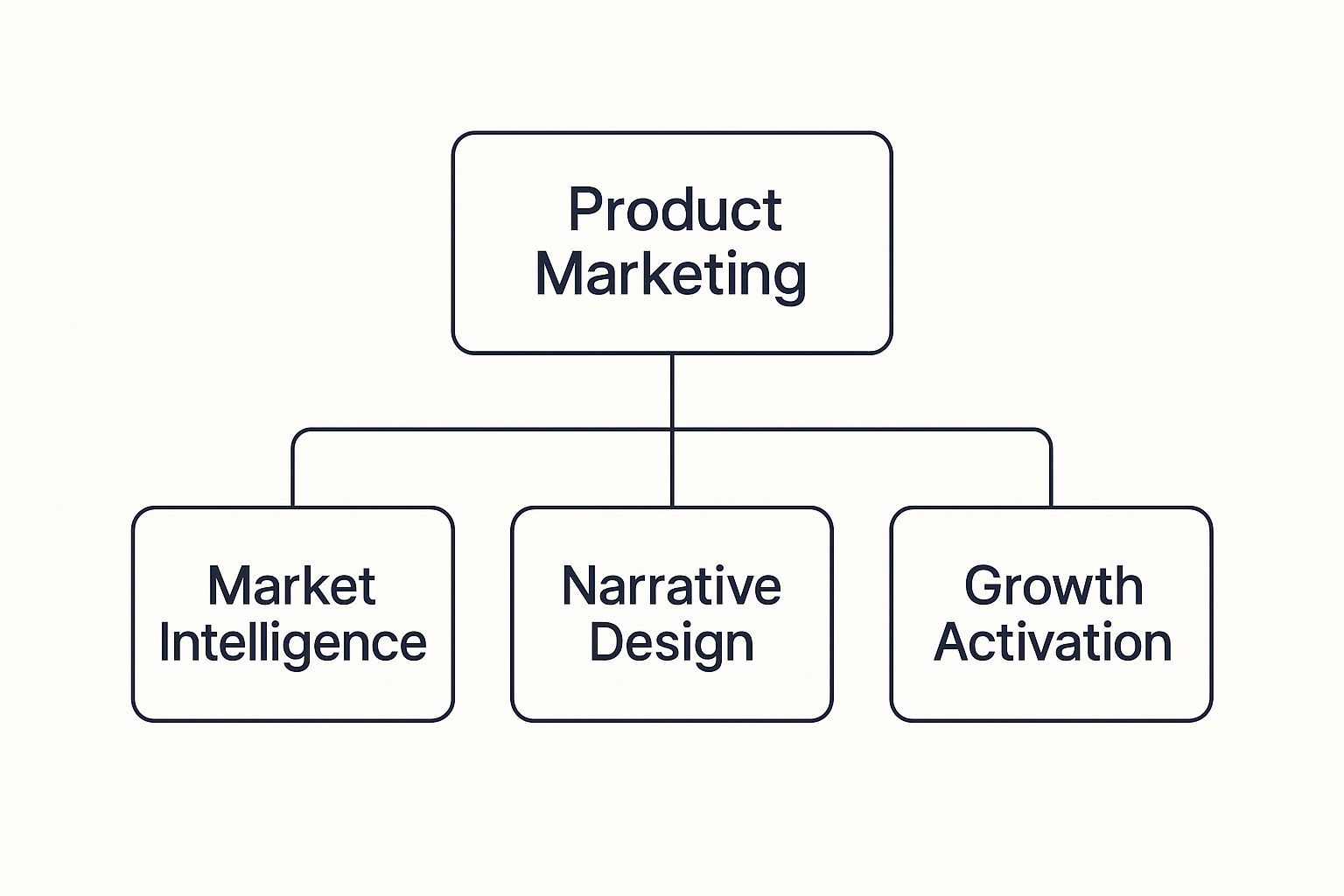What Does Product Marketing Do? Key Insights Explained
Discover what does product marketing do and how it enhances business growth. Learn the vital roles product marketers play in driving success.

So, what does a product marketer actually do?
Think of them as the strategic link between a brilliant product and the people who desperately need it. Their entire job revolves around deeply understanding the customer, shaping the product's story, and making sure that story connects with the right audience to spark growth.
The Conductor of Your Go-To-Market Symphony

Picture a world-class orchestra. You've got your masterful violinists (the product team), your powerful percussion section (sales), and your melodic woodwinds (marketing). Each group is a powerhouse on its own. But without a conductor, you just have noise.
The product marketer is that conductor. They aren't playing every instrument, but they are the ones who unify every team's efforts into a cohesive, powerful performance—a successful go-to-market launch. They make sure everyone is working from the same sheet music, all guided by a crystal-clear understanding of the audience.
Translating Features into Benefits
Let's get practical. Say your product team just shipped a groundbreaking feature: a faster data processing algorithm. That’s a huge technical win, but for a customer, "faster data processing" means... well, not much. It’s abstract. This is where the product marketer steps in.
Instead of leading with technical jargon, they spin a compelling narrative that speaks directly to the customer's pain points. That story then becomes the fuel for other teams:
- For the Marketing Team: It shapes the headline of an ad campaign or a landing page, turning an algorithm into a promise: "Slash Your Reporting Time by 50%."
- For the Sales Team: It provides them with powerful talking points and battle cards that connect the product directly to a prospect’s problems during a demo.
- For the Product Team: This feedback loop is pure gold. It helps them see which features create the most real-world value, guiding what to build next. You can see how this works in practice and learn how to request a feature that solves your specific challenges.
This kind of cross-functional harmony is what makes product marketing so essential. It’s not just about launching; it’s about setting the stage for sustained growth and market leadership.
To put it all together, here's a quick look at how the Product Marketing Manager (PMM) works with different parts of the business.
Product Marketing at a Glance
| Core Function | Primary Goal | Key Collaborators |
|---|---|---|
| Market Intelligence | Understand the customer, competition, and market landscape. | Product, Sales, Customer Success |
| Positioning & Messaging | Define the product's unique value and craft its core story. | Executive Leadership, Product, Marketing |
| Go-to-Market Strategy | Plan and orchestrate the launch of new products and features. | Sales, Marketing, Product, PR |
| Sales Enablement | Equip sales teams with the knowledge and tools to sell effectively. | Sales, Content Marketing |
| Content Creation | Develop assets that support the buyer's journey. | Marketing, Sales, Product |
This table shows just how central the role is. The PMM doesn't operate in a silo; they are the connective tissue that ensures the entire organization is aligned around a single, customer-focused vision.
The Three Pillars of Modern Product Marketing
If you want to get to the heart of what a product marketer really does, it helps to think of their role as resting on three core pillars. These aren't separate jobs but are all deeply intertwined, with each one building on the last. Everything a product marketer tackles will fall into one of these buckets: Market Intelligence, Narrative Design, or Growth Activation.
This simple hierarchy shows how these core functions feed into the larger product marketing strategy.

As you can see, market intelligence is the bedrock. You use that foundation to build a compelling narrative, and both are critical for activating growth successfully.
Pillar 1: Market Intelligence
The first pillar is Market Intelligence. Think of the product marketer as the company's resident detective, always gathering clues about the market, the customer, and the competition. This isn’t just about skimming reports; it's about becoming the undisputed "voice of the customer" inside the company.
Their investigation covers a few key areas:
- Customer Research: They're the ones conducting interviews, digging through survey data, and analyzing support tickets to truly understand what keeps customers up at night.
- Competitive Analysis: This means figuring out what rival products do well, where they stumble, and identifying the gaps where your product can uniquely shine.
- Persona Development: They build detailed, data-backed profiles of your ideal customers, which then become the north star for all messaging and strategic decisions.
This groundwork is absolutely non-negotiable. Without a solid foundation of market intelligence, any marketing effort is really just a shot in the dark. To really get a handle on the role, it's worth exploring its core definition, especially when you're defining product marketing for a B2B startup.
Pillar 2: Narrative Design
Once they have a deep understanding of the market, the product marketer shifts to the second pillar: Narrative Design. This is where raw data and customer insights are spun into a compelling story. It’s the art of translating what a product does (its features) into why a customer should care (its benefits).
This pillar is all about crafting the core message. It involves nailing down the product's positioning—how it stands apart from everything else out there—and its unique value proposition. The end goal is to answer one question for the customer with absolute clarity: "Why should I choose this over any other option?"
Pillar 3: Growth Activation
The final pillar, Growth Activation, is where strategy turns into action. This is the go-to-market (GTM) phase, where the product marketer orchestrates the launch and ongoing promotion of the product. They take the story they’ve so carefully crafted and make sure it reaches the right people at the right time.
This phase is heavy on cross-functional collaboration. The product marketer is a critical connector, with research showing 88.8% work closely with product teams and 81% collaborate daily with marketing departments. This work is also increasingly tied to the bottom line, as 53.2% of PMM teams now have revenue as a key performance indicator.
Key responsibilities at this stage include:
- Launching New Products: They plan and execute every detail of a product launch, from internal sales training to the big external announcement.
- Sales Enablement: They create the tools the sales team needs to win, like competitor battle cards, demo scripts, and powerful case studies.
- Driving Adoption: They partner with marketing teams on campaigns that build awareness, bring in new users, and keep them engaged for the long haul.
Taken together, these three pillars show the complete journey of a product marketer—from deep analysis to powerful storytelling and, finally, to driving real, measurable business growth.
A Day in the Life of a Product Marketer

To really get what a product marketer does, let’s ditch the theory and follow along with someone in the trenches. Meet Alex, a Product Marketing Manager (PMM) at a SaaS company. It's the week before a big feature launch, and things are about to get intense. This is where strategy, collaboration, and a little bit of controlled chaos come together.
Alex doesn’t kick off the week with a flashy creative meeting. Monday is all about the data. Alex is huddled with the product team, digging through customer feedback, poring over usage metrics from the beta, and hashing out the last few critical tweaks before launch.
In these meetings, Alex is the relentless advocate for the customer, constantly pushing the team with one simple question: “Sure, but what problem does this actually solve for them?” This keeps everyone grounded, ensuring the feature isn’t just a cool piece of tech but a genuine solution.
Crafting the Narrative
Come Tuesday, the focus flips from the what to the how. How are we going to talk about this thing? Alex gets to work on a comprehensive messaging brief, which becomes the single source of truth for the entire launch. This isn't just a list of talking points; it's the strategic DNA for the campaign, clearly defining the target audience, their biggest headaches, and why this new feature is the aspirin they've been waiting for.
This brief becomes the guidepost for every other team:
- Content: They’ll pull from it to craft compelling blog posts and case studies.
- Demand Gen: They’ll use its core messages to write ad copy that actually converts.
- PR: They’ll shape their media pitches around the story Alex has defined.
Without this document, you get a fractured, confusing message. With it, everyone is singing from the same hymn sheet. Alex is the conductor, translating complex product details into one clear, powerful story for the market.
Equipping the Front Lines
By mid-week, the focus shifts again—this time to the sales team. They're about to be peppered with questions from sharp prospects and hungry competitors. Alex’s job is to make sure they're ready for anything. The solution? A fresh set of "battle cards."
These aren't just cheat sheets; they're tactical one-pagers designed to help reps win deals. Each card is packed with:
- Key Talking Points: Simple, benefit-first phrases to nail the demo.
- Competitor Landmines: Smart ways to address tough questions about the competition.
- Customer Proof: Hard-hitting quotes and data from beta testers to prove the feature works.
As the week wraps up, Alex is in front of leadership, presenting the final go-to-market plan. This isn't a dry rundown of a checklist. It's a data-backed story that connects every launch activity—from the first email to the last ad—directly to adoption, engagement, and the bottom line. This dance between analysis, creativity, and leadership is the daily reality of product marketing.
How Product Marketing Drives Digital Discovery

In a world where attention is the most valuable currency, having a great product simply isn't enough. It has to be seen. This is where product marketing steps in, acting as the engine that powers a product’s journey into the hands and minds of potential customers online.
Think of it like this: the product team builds the car, but the product marketing team plots the entire road trip. They decide which highways to take, what radio stations to play, and which scenic routes will best capture the audience's imagination. They are the architects of a product's entire digital presence, using their deep understanding of the customer to cut through the endless online noise.
This all starts by translating the product’s core value into a language that resonates on specific platforms. After all, the way you’d describe a product on a professional network like LinkedIn is worlds away from how you’d showcase it on TikTok. A skilled product marketer is fluent in that kind of "code-switching."
Meeting Customers Where They Are
The modern customer journey rarely begins on a company’s homepage anymore. It starts in the scroll—on social feeds, in community forums, and through recommendations from trusted creators. The product marketer's job is to intercept customers at these critical points of discovery.
This insight shapes the entire go-to-market strategy:
- Social Media Campaigns: They don't just spray and pray. They pinpoint which platforms—whether it’s Instagram, Reddit, or LinkedIn—their ideal customers actually use and craft campaigns that feel native and helpful, not jarringly out of place.
- Influencer Partnerships: It's not about finding the creator with the most followers. It's about identifying partners whose audience genuinely mirrors the product's ideal customer profile, making the endorsement feel authentic.
- Targeted Digital Ads: Using detailed customer personas, they build highly specific ad campaigns. This ensures every dollar of the marketing budget is spent reaching people who will actually care about the product.
This work is more important than ever, as social platforms are quickly becoming the new search engines for product research. The data speaks for itself.
Creating a Powerful Feedback Loop
This digital-first strategy isn't just about broadcasting a message; it's about starting a conversation. When a product marketer launches a campaign on a platform like Instagram, they aren't just counting clicks. They're diving into the comments, tracking share sentiment, and monitoring DMs.
This raw, unfiltered feedback is gold. It creates a direct line back to both the product and marketing teams. Is the message connecting with people? Are customers confused about a specific feature? Are they bringing up a competitor that wasn't even on the radar?
By harnessing these real-world insights, product marketers constantly refine the product's story and positioning. This continuous loop of action and feedback ensures the product stays relevant and competitive, turning digital discovery from a one-way street into a dynamic, ongoing dialogue with the customer.
What About the Big Shift to Product-Led Growth?
One of the biggest evolutions happening in our field is changing the very answer to "what does a product marketer do?" For a long time, marketing’s job was simple: bring customers to the product. But now, especially in the SaaS world, the product itself has become the most powerful marketing channel.
This is the whole idea behind Product-Led Growth (PLG).
Instead of just relying on sales demos and fancy ad campaigns to show a product's value, PLG models let the product do the talking. The entire user experience is designed to drive acquisition, conversion, and even expansion. This change is massive. In fact, many believe that by 2025, a top-tier user experience with self-service onboarding won't just be a nice-to-have; it'll be the standard expectation. You can find more on this in Aventi Group's look at 2025 B2B product marketing trends.
In this new reality, the product marketer's role looks less like a billboard advertiser and a lot more like an expert tour guide living right inside the app. The goal is to make the product so intuitive and valuable that it practically sells itself.
The In-App Tour Guide
Think about the last time you downloaded a new app. In the old sales-led world, you might have gotten a call from a salesperson. In a product-led world, a product marketer has already crafted an experience that guides you from the very moment you sign up.
Their work is all about building that perfect in-product journey:
- Nailing User Onboarding: They're the ones behind the welcome screens, interactive tutorials, and helpful checklists that get you to that "aha!" moment as fast as possible.
- Crafting In-App Messaging: From the tiny tooltips that explain a feature to the pop-ups announcing an update, they write the words that guide you, help you, and get you to take the next step.
- Driving Feature Adoption: They figure out which features make users stick around for the long haul and then build campaigns to get more people using them.
This in-app work is absolutely essential for turning free trial users into happy, paying customers. To really get a grip on this approach, take a look at our guide on the fundamentals of product-led growth.
New Metrics for a New Model
This change in strategy also means product marketers are now tracking a whole new set of metrics—ones tied directly to what users are doing inside the product. While they still care about leads, their focus has broadened to KPIs that measure the health of the actual product experience.
Here are some of the key metrics in a PLG world:
- Activation Rate: What percentage of new users hit that key milestone that shows they've truly seen the product's value?
- Product-Qualified Leads (PQLs): These are users who have used the product enough to signal they're ready for an upgrade or a chat with sales.
- Free-to-Paid Conversion Rate: The percentage of trial users who become paying customers, often without ever talking to a human.
When product marketers own these numbers, their impact becomes crystal clear. They aren't just supporting the sales team anymore; they are building a growth engine that runs on its own, right inside the product.
Measuring the True Impact of Product Marketing
Product marketing often feels like a blend of art and science, but when it comes to proving its worth, the science has to win. We need to look past the vanity metrics and dig into the cold, hard data that shows how product marketing moves the needle.
Success isn't just one magic number; it's a moving target that changes throughout the product's life. Think about the pre-launch phase. Here, success is all about the quality of your homework. We’re talking about message testing scores that tell you if your story is resonating and market share analysis that confirms you’re aiming at the right target.
Key Metrics for Launch and Beyond
The moment a product is live, the game changes. All eyes are on how the market reacts and how people are actually using what you've built.
During that initial launch window, we're obsessing over things like:
- Adoption Rates: How fast are people signing up and getting started?
- Feature Usage: Are they using the killer features we spent months marketing?
- Press Mentions: Is the launch making waves and getting people talking?
After the launch confetti settles, the metrics get serious and tie directly to the company's financial health. This is where you see the real, long-term value of great product marketing. We’re now focused on revenue contribution, customer lifetime value (LTV), and our win-loss rates when we go head-to-head with competitors. These are the numbers that connect our work directly to the bottom line.
The best product marketing teams don't just launch products; they build engines for sustainable growth. Their success is ultimately measured by their ability to attract, keep, and grow a profitable customer base.
The metrics you track will also depend heavily on your company's growth model. A traditional sales-led organization might be laser-focused on sales-qualified leads. But in a product-led growth (PLG) company, the priorities shift to activation rates and product-qualified leads (PQLs).
For any model, a solid grasp of how to measure product-market fit is non-negotiable. And if you really want to get into the weeds of quantifying your team's impact, it’s worth exploring different ways of looking at how to measure marketing ROI.
Still Have Questions About Product Marketing? Let's Clear Things Up
Even after breaking down the role, a few common questions always seem to pop up. Let's tackle them head-on to give you a complete picture of what a product marketer really does.
Product Marketing vs. Product Management: What’s the Real Difference?
This is easily the most common point of confusion. While product marketers and product managers are two sides of the same coin, they focus on very different problems.
Product management is all about building the right product. They live in the world of user needs, business goals, and the technical roadmap, essentially acting as the architects of the solution. They answer the question: what should we build?
Product marketing, on the other hand, is about building the right market for that product. They take the finished solution and figure out how to launch it successfully. This involves crafting the story, defining the target audience, and creating the entire go-to-market plan.
Here's a simple way to think about it: Product management builds the car. Product marketing teaches the world why they need that specific car and makes them desperate to get behind the wheel.
Does the Job Change Much Between B2B and B2C?
Absolutely. The foundational goal of connecting a product with a customer is the same, but how you get there is worlds apart.
- In B2C (Business-to-Consumer), you're often speaking to a massive audience. The name of the game is brand building and emotional connection. The goal is to drive a high volume of sales, which usually happen pretty quickly. Think about the launch of the latest smartphone or sneaker.
- In B2B (Business-to-Business), the audience is smaller, the sales cycles are longer, and the deals are much larger. You're not just selling to one person; you're selling to a committee of decision-makers. The job here is to arm the sales team with everything they need—deep-dive case studies, technical whitepapers, and sharp competitive battle cards—to prove undeniable business value.
What Are the Must-Have Skills for a Great Product Marketer?
It takes a special mix of talents to thrive in this role. You can’t just be a great writer or a great strategist; you have to be a bit of both, and then some.
The best product marketers I've met are masters of strategic thinking, able to see the entire market landscape and carve out a unique space for their product. They couple this with exceptional communication and storytelling chops to make people care.
Because they sit at the center of so many teams, incredible collaboration skills are non-negotiable. And finally, they need strong analytical abilities to actually measure whether any of their work is making a difference.
At SigOS, we turn messy, complex customer feedback into clear, actionable insights. Our AI-powered platform helps your product team find the signal in the noise, so you can stop guessing and start building what your customers will actually pay for. Discover how SigOS can quantify the revenue impact of every feature request.


